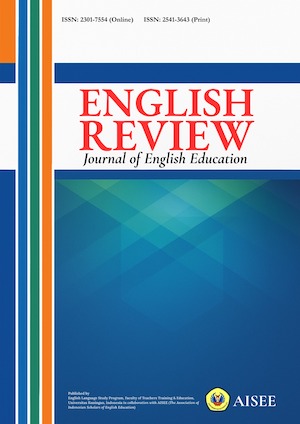INVESTIGATING THE EFFECT OF CANVA ON STUDENTS’ WRITING SKILLS
Abstract
A growing number of language teaching studies have started to consider the role of technology in teaching writing. Moreover, recent work in English as a Foreign Language (EFL) class has highlighted the importance of introducing visual media in an effort to help students improve their writing skills. The present study aims at investigating the effect of Canva on students’ writing skills. To this end, forty-four Indonesian EFL students were selected and assigned randomly to two writing classes, namely control and experimental groups. Before the treatment, both groups had a pre-test. During the sessions of instruction, both classes were taught by adopting Communicative Language Teaching (CLT) approach. However, in the experimental group, in order to help students to explore their writing ideas, they were asked to use Canva as media of writing. After the treatment, both groups had a post-test. Then, the number of writing errors made by students from both groups were compared using ANCOVA. The results showed that students in the experimental group had a significantly lower number of writing errors compared to the control group, which confirmed the positive effect of Canva in improving students’ writing skills.References
Alsubaie, J., & Ashuraidah, A. (2017). Exploring writing individually and collaboratively using Google Docs in EFL contexts. English Language Teaching, 10(10). doi: 10.5539/elt.v10n10p10.
Beaufils, A. F., & Duarte, J. (2018). To ICT or not to ICT: developing writing skills in an EFL professional training course. EDULEARN18 Proceedings. doi: 10.21125/edulearn.2018.1444.
Erguvan, I. (2015). Kuwaiti undergraduate students’ perceptions of ICT in writing classes. Arab World English Journal, 6(1), 280–297. doi: 10.24093/awej/vol6no1.22.
Franco-Camargo, L. F., & Camacho-Vásquez, G. (2018). The impact of wikis & videos integration through cooperative writing tasks processes. English Language Teaching, 11(5). doi: 10.5539/elt.v11n5p116.
Hernandez, R. M. (2017). Impacto de las TIC en la educación: Retos y perspectivas. Propósitos y Representaciones, 5(1). doi: 10.20511/pyr2017.v5n1.149.
Hyland, K. (2003). Second language writing. NY: Cambridge.
Lam, S. (n.d.). Evaluation of using ICT in teaching tertiary English writing. doi: 10.5353/th_b4413937.
Lee, K. (2000). English teachers’ barriers to the use of computer-assisted language learning. The Internet TESOL Journal, 6(12).
Liu, M., Moore, Z., Graham, L., & Lee, S. (2002). A look at the research on computer-based
technology use in second language learning: A review of the literature from 1990-2000. Journal of Research on Technology in Education, 34(3), 250-273.
Mackey, A., & Gass, S. M. (2005). Second language research methodology and design. New Jersey: Lawrence Erlbaum Associates.
Makalela, L. (2004). Differential error types in second-language students’ written and spoken texts: Implications for instruction in writing. Written Communication, 22(4), 368-385.
Smaldino, S. E., Lowther, D. L., Mims, C., & Russell, J. D. (2015). Instructional technology and media for learning. NY: Pearson.
Suhartono, S., & Laraswati, I. (2016). The use of visual media in teaching writing. English Education: Journal of English Teaching and Research, 1(1). doi: 10.29407/jetar.v1i1.274.
Suwantarathip, O., & Wichadee, S. (2014). The effects of collaborative writing activity using Google Docs on students’ writing abilities. The Turkish Online Journal of Educational Technology-TOJET, 13(2), 148-156.
Tinio, V. L. (2002). Survey of information & communication technology utilization in Philippine public high schools. Retrieved from http://www.fit-ed.org/downloads/ICT%20Utilization%20Survey.pdf.
Wahyuni, E., & Thohiriyah. (2018). Infographic: Avoiding monotony in presenting teaching materials. Proceedings of 2nd English Language Learning and Lirature International Conference (ELLiC), 2.
Wiyaka, W., Mujiyanto, J., & Rukmini, D. (2018). Students’ perception on the usefulness of ICT-based language program. English Language Teaching, 11(2). doi: 10.5539/elt.v11n2p53.
Ying, Z. (2018). Exploring construction of college English writing course from the perspective of output-driven hypothesis. English Language Teaching, 11(2), 188. doi: 10.5539/elt.v11n2p188.
Yundayani, A. (2018). Present situation analysis: Students’ early characteristics in writing for academic purposes. English Review: Journal of English Education, 6(2), 119-126.
doi: 10.25134/erjee.v6i2.1262.
Yuyun, I. (2018). Curriculum and technology design: A course to explore technology applications in EFL curriculum design. Journal of ELT Research, 3(1), 78. doi: 10.22236/jer_vol3issue1pp78-86.
Zamel, V. (1982). Writing: The process of discovering meaning. TESOL Quarterly, 16(2), 195-209.
Zhang, Y. (2018). Exploring EFL learners’ self-efficacy in academic writing based on process-genre approach. English Language Teaching, 11(6), 115. doi: 10.5539/elt.v11n6p115.
All articles published in English Review: Journal of English Education (ERJEE) are licensed under the Creative Commons Attribution 4.0 International License (CC BY 4.0).
Copyright Ownership
Authors retain the copyright of their articles and grant ERJEE the right of first publication. The journal is granted a non-exclusive license to publish, reproduce, and distribute the article in any format, medium, or platform, provided that proper credit is given to the original authors.
License Terms – CC BY 4.0
Under the Creative Commons Attribution 4.0 International License, others are free to:
- Share — copy and redistribute the material in any medium or format
- Adapt — remix, transform, and build upon the material for any purpose, even commercially
As long as they:
- Provide appropriate credit to the original author(s) and source
- Provide a link to the license (https://creativecommons.org/licenses/by/4.0/)
- Indicate if any changes were made
There are no restrictions on the reuse, reproduction, or adaptation of published articles as long as attribution is properly given.
Author Warranties
By submitting a manuscript to ERJEE, authors confirm that:
- The work is original and does not infringe any existing copyright.
- The manuscript has not been previously published and is not under consideration elsewhere.
- All sources and references are appropriately acknowledged.
- Necessary permissions have been obtained for any copyrighted materials used.









